

Imagine yourself at a crossroads. You’re staring down the exciting, yet daunting, path of higher education. Questions swirl in your mind: “What career path should I take?”, “What type of degree is right for me?”, and most importantly, “Which college will help me achieve my goals?”. This is the beginning of the student journey, a crucial decision-making process that every aspiring student embarks on.
Interestingly, this journey often starts with a simple search on Google. Whether it’s “best colleges for engineering” or “tips for choosing a major,” students are actively seeking information online to guide their decisions. This is where Search Engine Optimization (SEO) for Higher Education comes into play.
SEO is the art and science of making your website visible in search engine results. But for higher education institutions, it’s much more than just ranking high. It’s about influencing the student journey at every stage, from initial awareness to final enrollment. So, let’s unpack this journey and see how SEO can be your guide along the way.
The first step in the student journey is awareness. Students are just beginning to explore their options, and their minds are brimming with questions. They might be unsure about their desired field, the type of degree they need, or even the very concept of college life.
As a higher education institution, SEO can help you be there at the right time with the right information. This is achieved through keyword research and content creation. By identifying the keywords students are searching for (e.g., “best colleges for social work”, “what does a computer science degree entail?”), you can create informative blog posts, articles, and guides that address their concerns and answer their questions.
Imagine this: A student unsure about their major stumbles upon your article titled “5 Tips for Choosing the Right College Major.” This article, optimized with relevant keywords like “choosing a college major”, “career paths”, and “finding your passion”, guides them through the decision-making process, potentially sparking their interest in your programs.
This is exactly what The University of Kansas has done. Their article “10 Tips for Choosing a Major in College” gets close to 2,000 clicks/mo and ranks in the top positions for keywords like:
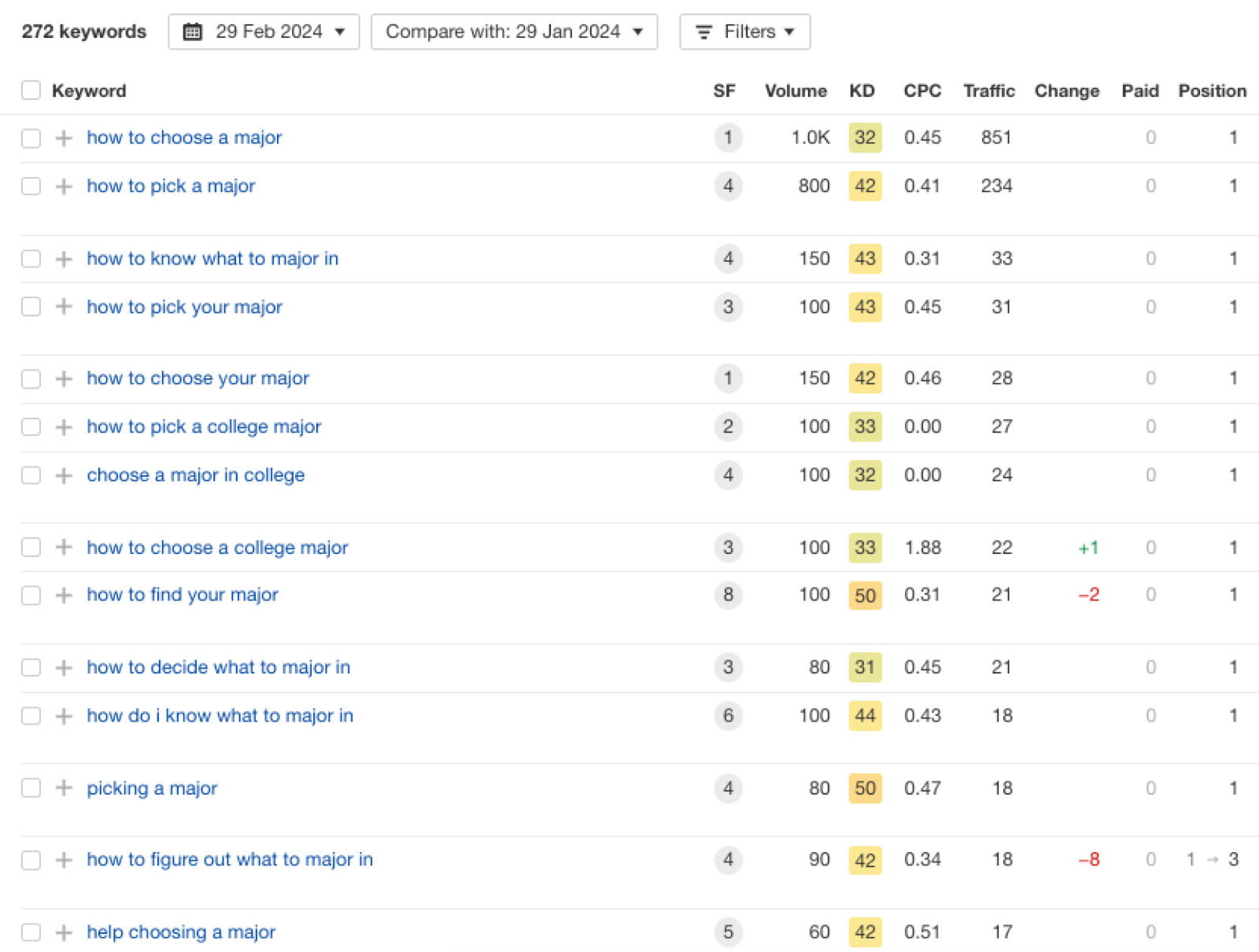
From this research, they might become interested in getting a computer science degree. However, they want to learn more about the program and what they can do with a computer science degree. So they would search for [what do you learn in computer science]. SNHU has an article on this topic (What Can You Do With a Computer Science Degree?), and that page alone brings them over 1,800 clicks every month.
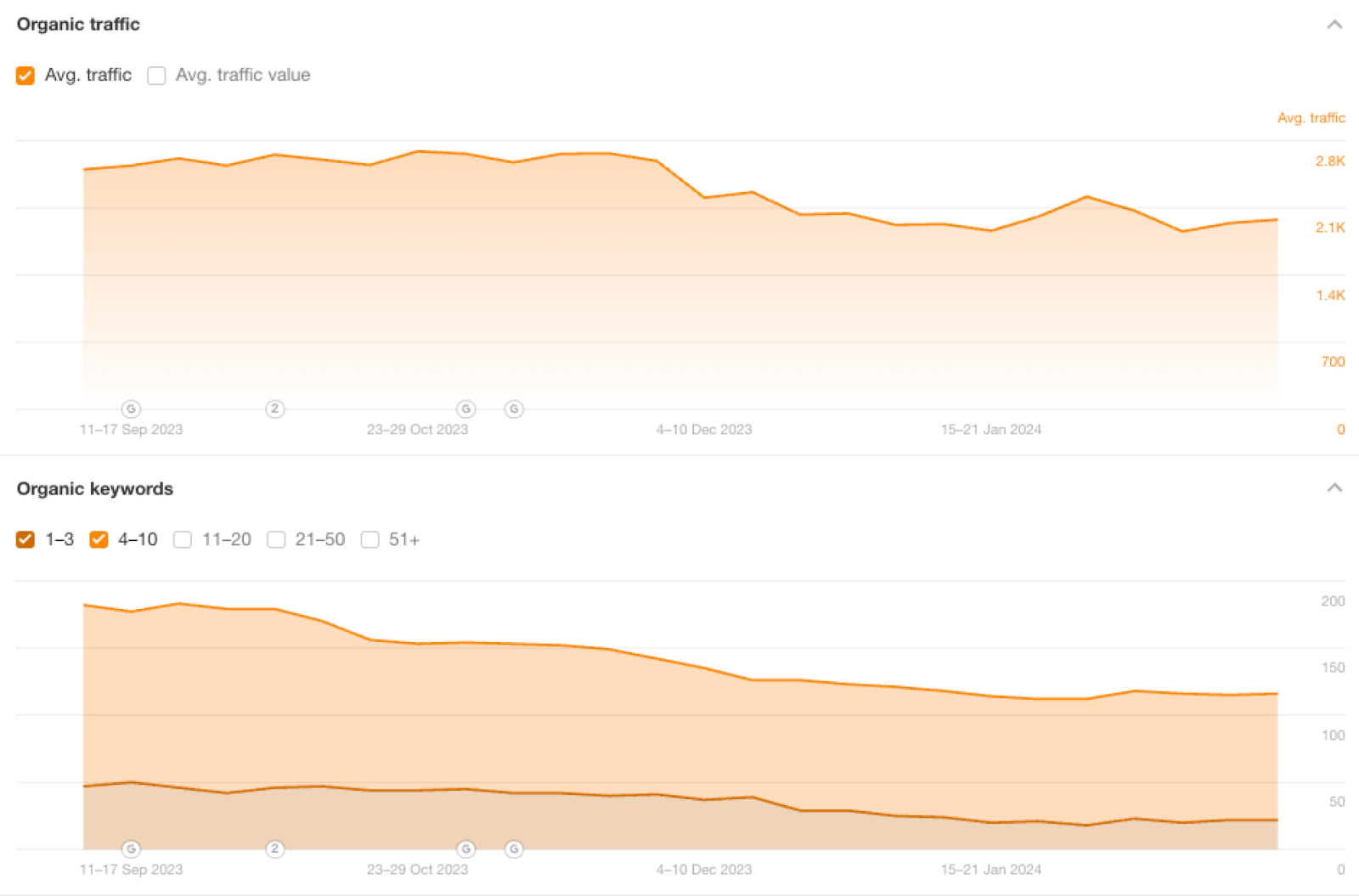
Once students have a better understanding of their interests and goals, they move into the consideration stage. This is where they start researching specific colleges and programs, learning more about things like curriculum, faculty expertise, and even campus life.
In this phase, SEO becomes even more critical. You can create content with relevant keywords related to specific programs and majors (e.g., “computer science vs computer engineering”, “is computer science a good major”). Additionally, ensure your website is user-friendly and provides clear information about programs, faculty profiles, and student life. This makes it easier for students to find the information they need and assess if your institution aligns with their aspirations.
Rice University’s Department of Computer Science has an article titled “Computer Science vs Computer Engineering: What’s the Difference?”. This article brings them over 5,400 clicks every month (64,800 visits annually) and ranks for over 630 keywords.
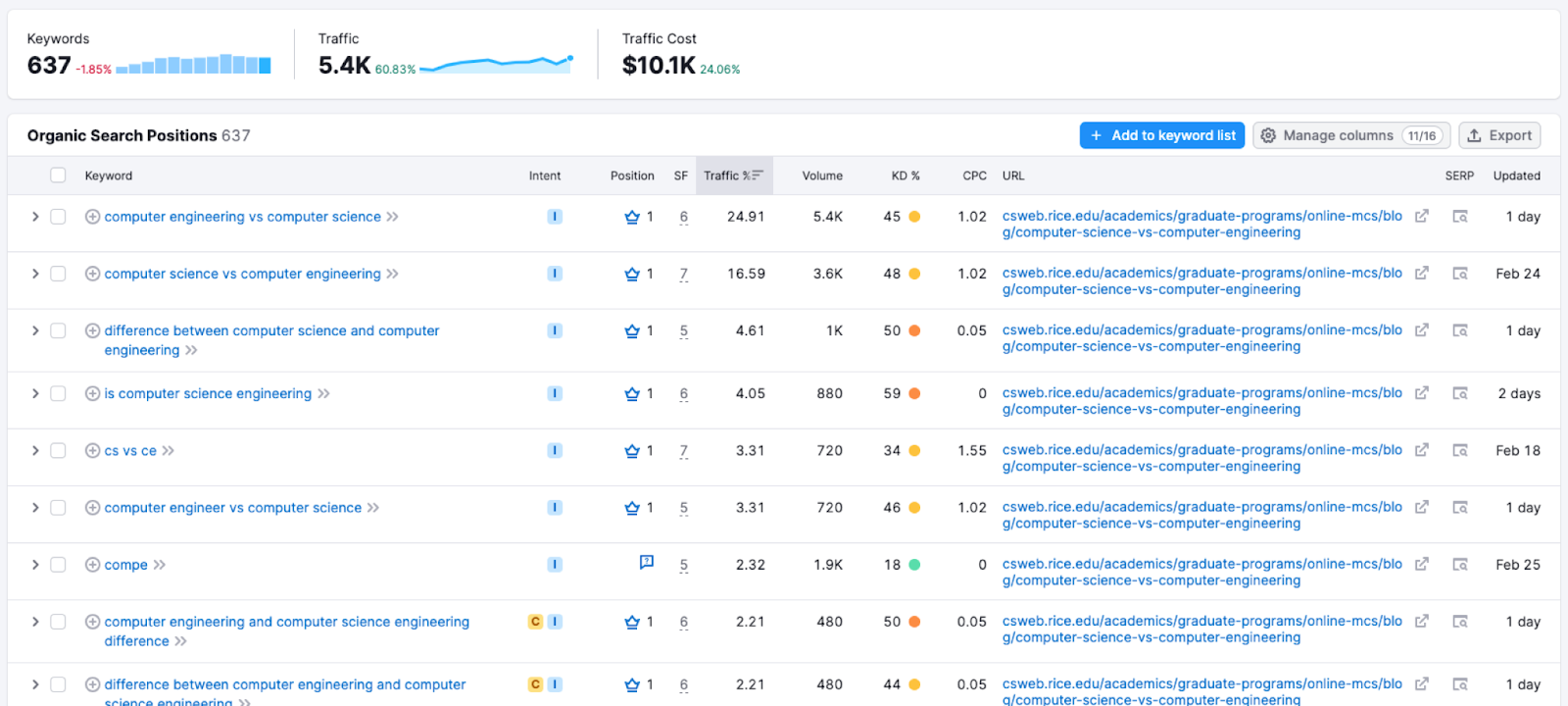
By appearing in search results, this article reaches students with initial program interest but may not be ready for immediate action. This visibility benefits Rice’s brand; every year, tens of thousands of prospective students land on this page, with a significant number engaging with their calls to action and learning more about Rice’s Computer Science program.
Think of it this way: A student interested in computer science lands on your website’s “Computer Science” blog article. The page is optimized with relevant keywords and offers a clear overview of the program, including course descriptions, faculty profiles, and internship opportunities. This transparency and ease of access can significantly influence their decision to explore further or even apply.
After they’re done with their questions, they are going to search for specific programs. You should be visible here, too, as these searches have a clear intent to convert. They are also one of the most competitive keywords to rank for.
The most important thing to remember here is to understand the search intent and use that information to target the right keywords for your program page. You’d think that targeting the (computer science degree) keyword with your program page is the right decision, but the screenshot below proves you wrong. There’s only one program page ranking for this keyword, all other results are informational content (blog articles).
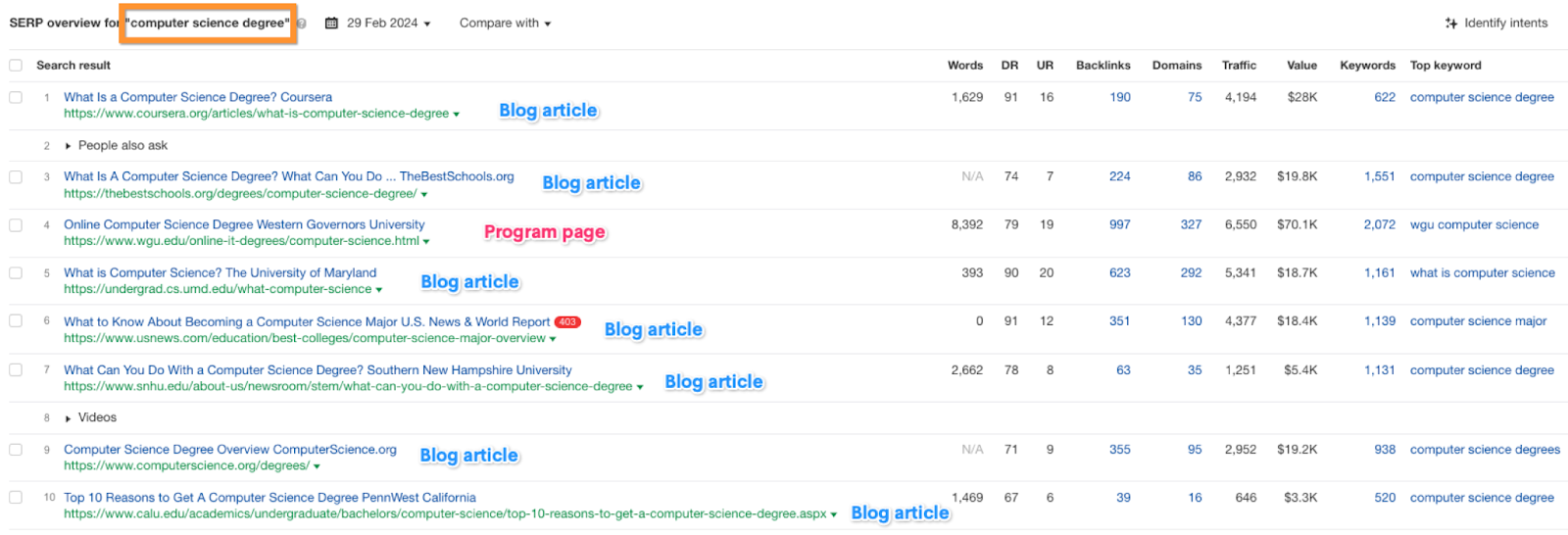
If you want to rank for this keyword, the best chance you’ll have at ranking will be through blog content that targets this keyword. And for the program page, you’d probably want to target a different version of this keyword that shows more program pages listed.
Here’s one example of search results showing only program pages when you search for (online computer science degree), a keyword that is searched over 9,000 times every month. Because the search query is more specific, this signals Google that the user is interested in programs and not blog articles.
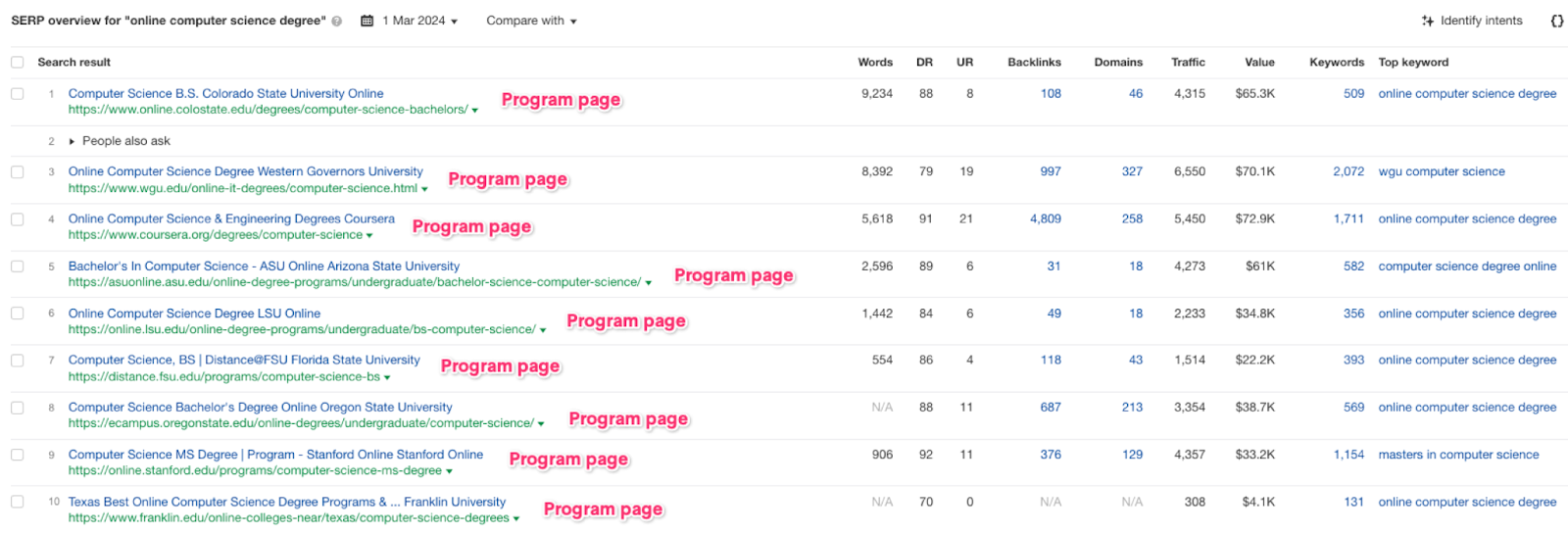
The decision stage is where students finalize their choices, considering factors like financial aid options, campus visits, and acceptance rates. As an institution, you want to ensure you’re providing the information and resources that make your option stand out.
SEO can help you showcase the unique selling points of your institution during this crucial stage. You can highlight testimonials from current students and alumni, emphasizing their positive experiences and career successes. Additionally, you can create landing pages dedicated to financial aid information and the application process, making it easy for students to navigate the next steps.
For example, imagine a student on the fence, torn between two colleges. They visit your website and discover a dedicated landing page titled “Scholarships and Financial Aid.” This page clearly explains eligibility requirements, application procedures, and even features success stories of students who received scholarship support. This level of transparency and accessibility can significantly impact their final decision.
By understanding the student journey and implementing a strategic SEO approach, higher education institutions can effectively guide prospective students from initial awareness to successful enrollment. Remember, SEO is a continuous process, and it requires ongoing effort to stay ahead of the curve. But by prioritizing relevant content, user experience, and transparency, you can harness the power of SEO to attract the right students and build a thriving academic community.

SEO Director, Co-Founder
Granit is the Co-Founder & SEO Director at Manaferra.
Granit is the Co-Founder & SEO Director at Manaferra.
Stay up to date with the latest marketing, sales, and service tips and news.